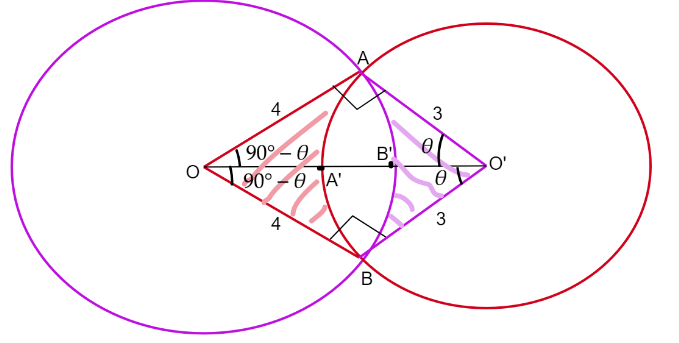
Circles of radii $3$ and $4$ intersect orthogonally. The area common to the two circles is
A. $8\pi + 12 - 7{\tan ^{ - 1}}\dfrac{4}{3}$
B. $8\pi - 12 - 7{\tan ^{ - 1}}\dfrac{4}{3}$
C. $8\pi - 12 + 7{\tan ^{ - 1}}\dfrac{3}{4}$
D. $\dfrac{{9\pi }}{2} - 12 + 7{\tan ^{ - 1}}\dfrac{3}{4}$
Answer
217.8k+ views
Hint: In this question, we are given the radii of circles and we have to find the common area of both the circles. First step is to draw the figure. Then, find the area of quadrilateral AOBO’ which is made by the intersection of circles. Now, shade that part of the quadrilateral which is not common in both circles and find the particular area by subtracting the connecting sector from the area of the quadrilateral. Same for the other portion. Lastly, subtract the shaded area from the total area. Required area will be the area of the common part.
Complete step by step solution:
Given that,

Radii of the circle are $3$ and $4$ units which intersect orthogonally.
Area of the quadrilateral AOBO’$ = $ $2 \times $ area of triangle OAO’
Therefore, $Ar.AOBO' = 2 \times \left( {\dfrac{1}{2} \times 4 \times 3} \right) = 12$
Now, the area of the portion $AOBA'$(Red shaded part) $ = Ar.AOBO' - ArAO'BA'$
$ = 12 - \left( {\dfrac{1}{2}{{\left( 3 \right)}^2}\left( {2\theta } \right)} \right)$
$ = 12 - 9\theta $
Similarly, the area of the portion $AO'BB'$(Purple shaded part) $ = Ar.AOBO' - ArAOBB'$
$ = 12 - \left( {\dfrac{1}{2}{{\left( 4 \right)}^2}\left( {2\left( {{{90}^ \circ } - \theta } \right)} \right)} \right)$
Write the angle in radian terms,
$ = 12 - 16\left( {\dfrac{\pi }{2} - \theta } \right)$
$ = 12 - 8\pi + 16\theta $
Therefore, Area common to the two circles ($AA'BB'$)$ = Ar.AOBO' - Ar.AOBA' - Ar.AO'BB'$
$ = 12 - \left( {12 - 9\theta } \right) - \left( {12 - 8\pi + 16\theta } \right)$
$ = 8\pi - 12 - 7\theta - - - - - \left( 1 \right)$
Here in right- angled triangle $AOO'$,
$\tan \theta = \dfrac{{perpendicular}}{{base}}$
$\tan \theta = \dfrac{4}{3}$
$\theta = {\tan ^{ - 1}}\dfrac{4}{3}$
Putting the above value in equation (1),
$Ar.AA'BB' = 8\pi - 12 - 7{\tan ^{ - 1}}\dfrac{4}{3}$
Hence, Option (B) is the correct answer i.e., $8\pi - 12 - 7{\tan ^{ - 1}}\dfrac{4}{3}$.
Note: The key concept involved in solving this problem is the good knowledge of formulas of areas. Students must remember that to solve such question making figures is mandatory. Without figure questions it will be confusing. Also, while taking the angle of the sector, double the angle and both the triangles have different angles.
Complete step by step solution:
Given that,

Radii of the circle are $3$ and $4$ units which intersect orthogonally.
Area of the quadrilateral AOBO’$ = $ $2 \times $ area of triangle OAO’
Therefore, $Ar.AOBO' = 2 \times \left( {\dfrac{1}{2} \times 4 \times 3} \right) = 12$
Now, the area of the portion $AOBA'$(Red shaded part) $ = Ar.AOBO' - ArAO'BA'$
$ = 12 - \left( {\dfrac{1}{2}{{\left( 3 \right)}^2}\left( {2\theta } \right)} \right)$
$ = 12 - 9\theta $
Similarly, the area of the portion $AO'BB'$(Purple shaded part) $ = Ar.AOBO' - ArAOBB'$
$ = 12 - \left( {\dfrac{1}{2}{{\left( 4 \right)}^2}\left( {2\left( {{{90}^ \circ } - \theta } \right)} \right)} \right)$
Write the angle in radian terms,
$ = 12 - 16\left( {\dfrac{\pi }{2} - \theta } \right)$
$ = 12 - 8\pi + 16\theta $
Therefore, Area common to the two circles ($AA'BB'$)$ = Ar.AOBO' - Ar.AOBA' - Ar.AO'BB'$
$ = 12 - \left( {12 - 9\theta } \right) - \left( {12 - 8\pi + 16\theta } \right)$
$ = 8\pi - 12 - 7\theta - - - - - \left( 1 \right)$
Here in right- angled triangle $AOO'$,
$\tan \theta = \dfrac{{perpendicular}}{{base}}$
$\tan \theta = \dfrac{4}{3}$
$\theta = {\tan ^{ - 1}}\dfrac{4}{3}$
Putting the above value in equation (1),
$Ar.AA'BB' = 8\pi - 12 - 7{\tan ^{ - 1}}\dfrac{4}{3}$
Hence, Option (B) is the correct answer i.e., $8\pi - 12 - 7{\tan ^{ - 1}}\dfrac{4}{3}$.
Note: The key concept involved in solving this problem is the good knowledge of formulas of areas. Students must remember that to solve such question making figures is mandatory. Without figure questions it will be confusing. Also, while taking the angle of the sector, double the angle and both the triangles have different angles.
Recently Updated Pages
Arithmetic, Geometric & Harmonic Progressions Explained

Cartesian Form of Vector Explained: Formula, Examples & Uses

Apparent Frequency Explained: Formula, Uses & Examples

Calorimetry: Definition, Principles & Calculations

Centrifugal Force Explained: Definition, Formula & Examples

Charge in a Magnetic Field: Definition, Formula & Examples

Trending doubts
JEE Main 2026: Application Form Open, Exam Dates, Syllabus, Eligibility & Question Papers

Derivation of Equation of Trajectory Explained for Students

Hybridisation in Chemistry – Concept, Types & Applications

Understanding the Angle of Deviation in a Prism

Understanding Collisions: Types and Examples for Students

Understanding Atomic Structure for Beginners

Other Pages
JEE Advanced Marks vs Ranks 2025: Understanding Category-wise Qualifying Marks and Previous Year Cut-offs

NCERT Solutions for Class 11 Maths Chapter 10 Conic Sections

NCERT Solutions for Class 11 Maths Chapter 9 Straight Lines

NCERT Solutions For Class 11 Maths Chapter 8 Sequences And Series

How to Convert a Galvanometer into an Ammeter or Voltmeter

NCERT Solutions For Class 11 Maths Chapter 12 Limits And Derivatives




